Originally established in 1769 under Spanish rule when Mission San Diego de Alcalá and the Presidio were built, San Diego began to grow after Mexico gained independence in 1821. In 1846 the USA declared war on Mexico and San Diego changed hands several times before the 1848 Treaty of Guadalupe Hidalgo drew the border line just south of the city. San Diego was incorporated as a city in 1850 and it is now the second largest city in California.
Loof Carousel, Seaport Village
Marinas are found along much of the modern waterfront but near the intersection of West Harbor Drive with Market Street the waterfront has been developed for a different purpose. Seaport Village is a bayfront marketplace filled with restaurants and small shops. A recent addition to the village is a restored 1895 carousel built by Charles I.D. Looff, one of the foremost US carousel designers in the late 19th and early 20th centuries. This carousel came from Salisbury Beach in Massachusetts. It has 54 hand carved animals including a giraffe, dragon, elephant, camel, teddy bear, lion and dog as well as two horse-drawn chariots.
Mission Beach
While the downtown waterfront area is sheltered by Point Loma and Coronado Island, further north the coast is at the mercy of the Pacific Ocean. Mission Beach is a sandy strand of around 3 kilometres (2 miles) in length that shelters Mission Bay from the ocean. Development of the strand began in the 1930s with the construction of summer cottages and now Mission Beach is the most densely developed residential area in San Diego. A boardwalk runs along the length of the beach in front of the beach front buildings.
Downtown San Diego
Home to over 1.2 million people, San Diego has its centre on a bay sheltered from the Pacific Ocean by Point Loma & Coronado. There has been a major naval presence here for over 100 years and the city is also a significant centre for bioscience and drug companies. For tourists, San Diego can easily compete with Los Angeles and San Francisco but can be eclipsed by being just a little too close to the sprawl of LA. Yet it has much that LA lacks. The city is home to the original Sea World and a famous zoo. It has the vibrant feel of a border town with the inevitable mixture of cultures. In addition to the skyscrapers seen in this picture, the downtown area still has many old buildings. Click Tab 2 to see a similar view of downtown San Diego at night.


Mission Bay & West Mission Bay Drive
Protected by Mission Beach is an area that was once a tidal marsh. Juan Rodriguez Cabrillo named it ‘False Bay’ back in 1542. In 1944 it was decided that the San Diego economy needed to be diversified from its base which was then primarily military. Tourism was seen as the best way to broaden the economy so the tourist unfriendly False Bay was renamed Mission Bay. It was dredged to create water channels with the recovered sand and silt used to raise the level of the remaining land above sea level. The once marshy area is now about half water and half land. Mission Bay is now a park used for recreational activities. Development has not been permitted within the park apart from SeaWorld near the south.
San Diego
Beach at La Jolla, San Diego, CA, USA
Heading further north from Mission Bay, you come to a suburb of San Diego that is also a seaside resort. La Jolla (pronounced ‘lah-HOY-yah’) has a population of around 44,000 people and it occupies the strip of land between Interstate 5 and the coast. This picture is looking north across Wipeout Beach. Below the headland visible in the centre is Children’s Pool Beach, a hang out for some other La Jolla residents, Harbour Seals. Click Tab 2 to see a typical La Jolla beach activity - surfing.
Click on Minimap to navigate
Home > US States > The West > California >
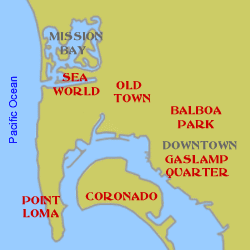
Click on Minimap to navigate
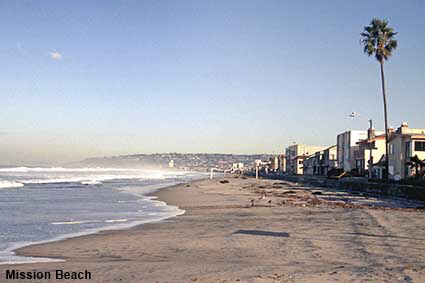
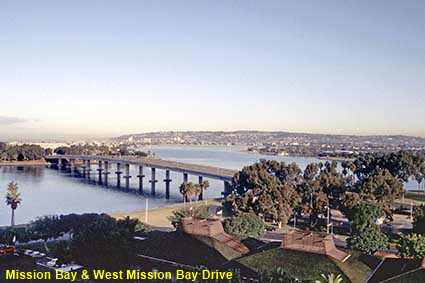
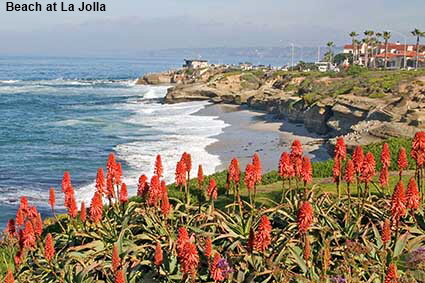


Click the arrows above to continue on the California Trail. We have other pages on Los Angeles. To see them click below or on the Minimap:
DLU080315
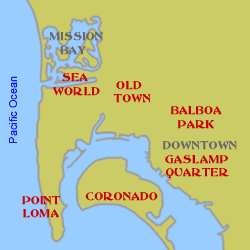

© Mike Elsden 1981 - 2025
The contents of this page may not be reproduced in full or in part without permission